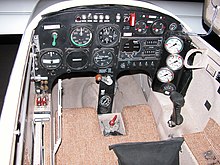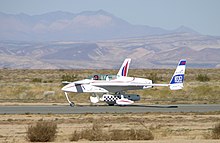XCOR EZ-Rocket


The XCOR EZ-Rocket is a test platform for the XCOR rocket propulsion system. The airplane is a modified Rutan Long-EZ, with the propeller replaced by first one, then later a pair of pressure-fed regeneratively cooled liquid-fuelled rocket engines and an underslung fuel tank. The engines are restartable in flight, and are contained within Kevlar armor shielding. The EZ-Rocket is registered as an experimental aircraft.
Development and history
The first flight took place on July 21, 2001, flown by test pilot Dick Rutan.[1]
On a typical flight, the EZ-Rocket takes off on rockets, gains altitude for a minute or so, then switches off the rockets and glides to a deadstick landing.
The vehicle actually flies better during deadstick glide landings than a Long-EZ due to lack of drag from a stationary pusher propeller — the vehicle's aerodynamics are cleaner in spite of its belly tank. It is also lighter due to the lack of a piston engine (the rocket propulsion system is significantly lighter), so enjoys significantly lower wing loading than a stock Long-EZ.
When XCOR began flying its EZ-Rocket in 2001, the company decided to have it FAA certified as an experimental aircraft, avoiding the additional time required to seek a launch vehicle license from the Office of Commercial Space Transportation (AST). Jeff Greason, a co-founder of XCOR, said on February 10, 2003 if they were starting out at that time they probably would seek an AST license due to the progress made in developing a regulatory regime for suborbitals.[2]
Milestones and records

- October 8, 2000 - First firing of an XCOR Aerospace LOX-powered rocket engine.[3]
- July 21, 2001 - First flight, flown by Dick Rutan (single-engine configuration).[3]
- October 3, 2001 - First flight in twin-engine configuration.[3]
- June 24, 2002 - First touch-and-go of a rocket-powered aircraft (world record).[3]
- December 3, 2005 - Set the point-to-point distance record for a ground-launched, rocket-powered aircraft, flying 16 km from Mojave to California City in just under ten minutes, flown by Dick Rutan.[4][5] Also first official delivery of U.S. Mail by a rocket-powered aircraft.[4] In recognition of this achievement, the FAI awarded Rutan the 2005 Louis Blériot Medal.[6]
- December 15, 2005 - First cross-country return flight of a rocket-powered aircraft in the United States, return flight from California City, piloted by Rick Searfoss.[4]
- 2008: The XCOR EZ-Rocket X-Racer prototype rocketplane flew at the 2008 EAA AirVenture Oshkosh air show.[7]
Derivatives
The Rocket Racing League aircraft currently in development, the Mark-III X-racer, is a design descendant of the EZ-Rocket aircraft. Although XCOR is not the developer of the rocket engine for the Mark-III, XCOR did develop the rocket engine for the Mark-I X-Racer, the first of the X-Racers to use a single rocket engine on a Velocity SE basic airframe, and the first X-Racer to utilize kerosene instead of isopropyl alcohol fuel. XCOR used both design and operational experience from the EZ-Rocket in the Mark-I rocket aircraft design.[citation needed]
Specifications


- Two XR-4A3 400 lbf (1.8 kN) thrust rocket engines (non throttleable, restartable in flight)[8]
- 20 sec 500 m takeoff roll
- Vne = 200 kt
- climb rate = 52 m/s (10,000 ft/min)
- maximum altitude = 11,546 ft MSL
- Fuel: isopropyl alcohol and liquid oxygen
- Chamber pressure: ~ 350 psi
- Specific impulse: 250 seconds (2.5 km/s) to 270 seconds (2.6 km/s)[citation needed]
- Noise: 128 dB at 10 meters[9]
See also
References
- ^ Flight Tests Of XCOR’s EZ-Rocket and Progress Toward a Microgravity and Microspacecraft Launcher
- ^ http://www.hobbyspace.com/AAdmin/archive/RLV/2003/RLVNews2003-02.html#Feb.11.03
- ^ a b c d "First Flights - XCOR Aerospace". Mojave Virtual Museum. Archived from the original on 2006-11-10. Retrieved 2006-11-13.
- ^ a b c Deaver, Bill (2005-12-22). "XCOR EZ-Rocket makes more history at CalCity". Mojave Desert News.
{{cite news}}: Cite has empty unknown parameter:|coauthors=(help) - ^ FAI Records Archived March 10, 2007, at the Wayback Machine
- ^ List of Blériot medals awarded to Dick Rutan[permanent dead link]
- ^ XCOR X-Racer, by Nancy Atkinson, Universe Today, 2009-08-06, accessed 2010-04-26.
- ^ "LOX-Alcohol Rocket Engine". www.xcor.com. XCOR Aerospace, Inc. Archived from the original on 2015-06-26. Retrieved 2015-06-15.
- ^ "Archived copy". Archived from the original on February 20, 2009. Retrieved January 29, 2009.
{{cite web}}: CS1 maint: archived copy as title (link)
